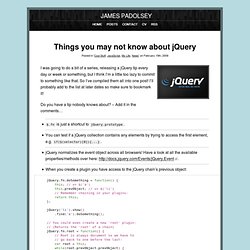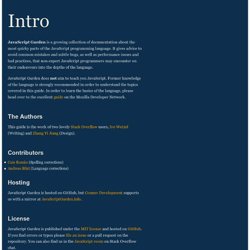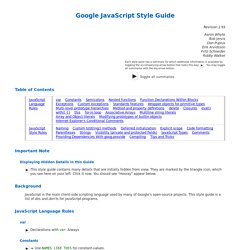

Edit this Fiddle. JavaScript Patterns. Improve your jQuery - 25 excellent tips. Official jQuery Blog - powered by FeedBurner. Things you may not know about jQuery. I was going to do a bit of a series, releasing a jQuery tip every day or week or something, but I think I’m a little too lazy to commit to something like that.

So I’ve compiled them all into one post! I’ll probably add to the list at later dates so make sure to bookmark it! Do you have a tip nobody knows about? – Add it in the comments… JavaScript Garden. Function Declarations and Expressions Functions in JavaScript are first class objects.

That means they can be passed around like any other value. One common use of this feature is to pass an as a callback to another, possibly asynchronous function. The function Declaration function foo () {} The above function gets hoisted before the execution of the program starts; thus, it is available in the scope it was in, even if called before the actual definition in the source. foo (); // Works because foo was created before this code runs The function Expression var foo = function () {}; This example assigns the unnamed and function to the variable foo . foo ; // 'undefined' foo (); // this raises a TypeError Due to the fact that var is a declaration that hoists the variable name foo before the actual execution of the code starts, foo is already defined when the script gets executed.
Named Function Expression Another special case is the assignment of named functions. var foo = function bar () { this ; b. Google JavaScript Style Guide. We follow the C++ formatting rules in spirit, with the following additional clarifications.

Curly Braces Because of implicit semicolon insertion, always start your curly braces on the same line as whatever they're opening. For example: if (something) { // ... } else { // ... } Array and Object Initializers Single-line array and object initializers are allowed when they fit on a line: Multiline array initializers and object initializers are indented 2 spaces, with the braces on their own line, just like blocks. JavaScript. JavaScript (JS) is a lightweight, interpreted, or just-in-time compiled programming language with first-class functions. While it is most well-known as the scripting language for Web pages, many non-browser environments also use it, such as Node.js, Apache CouchDB and Adobe Acrobat. JavaScript is a prototype-based, multi-paradigm, dynamic language, supporting object-oriented, imperative, and declarative (e.g. functional programming) styles.
Read more about JavaScript. This section is dedicated to the JavaScript language itself, and not the parts that are specific to Web pages or other host environments. For information about APIs specific to Web pages, please see Web APIs and DOM. The standard for JavaScript is ECMAScript. Tutorials Learn how to program in JavaScript with guides and tutorials. For complete beginners Head over to our Learning Area JavaScript topic if you want to learn JavaScript but have no previous experience of JavaScript or programming.